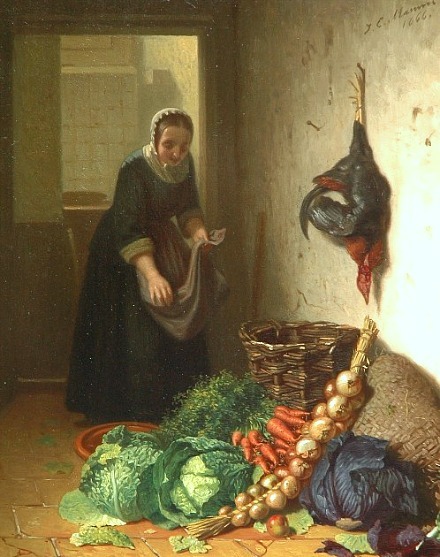Many of us that cook & make period recipes do not have the luxury of having a fully stocked reproduction kitchen for our own use. While I have cooked in period kitchens, most of the time I am stuck in a camp setting with a fire pit for a hearth. So, what do we do in these situations? Do we drag every piece of crockery we own to an event? Well, no. I am usually in the civilian part of a camp so I don't really need a back story other than the "We have to eat" one. When cooking in a camp setting I usually go with the basics. I establish what I will be cooking
before the event. I have cooked as a group, which does cut down on cost & labor! But I have also cooked for group by myself & established a price based on the menu.
So, before the event. Decide on what you (or the group) will eat and how many you will be cooking for. Usually 4 or 5 meals, some events do offer a supper on Saturday night, but sometimes I opt out of this. So you will need at least 2 breakfasts, 2 lunches and one dinner/supper. The way I plan these meals depends on the type of event & the time of the year. There are a lot of factors that go into meal planning, but it is so worth it to have a plan of attack.
Breakfast- easy, easy, easy! It's early, the fire is not ready, do not try to do a full coarse breakfast. Go with fruit, bread, cheese, eggs (easy to cook on the morning fire). Set this meal up "buffet" style with options for those waiting to eat.
Lunch- this can be as easy or as difficult as you would like. Soups are always a good way to go, unless the heat prevents such things. A vegetable soup is so easy to prepare on site. Bring plenty of root vegetables that can be cut & peeled on site, this makes an awesome demo in today's canned & frozen food world (root veggies require no refrigeration!). The soup allows you to cook but does not require constant monitoring, just an occasional stir. A cold buffet is another option. Cold buffets can offer a variety of options for a full crowd. Bread, cheese, fruit, pickles, boiled eggs, cold ham, salads, cakes, the options really are endless. If you really want to cook, again the options are endless. A boiled or roast meant (fowl or beef), some veggies, and your good to go! Some spectators are really entertained at seeing meat on a spit, so please caution people to not touch your meal.
Dinner/Supper- Again, this can be easy or elaborate. Usually I can concentrate most of my time on making a nice evening meal, preparing it throughout the day. This usually is a nice roasted or stewed meat with plenty of sides. I chose the sides based on what vegetables are in season for the area. Usually bread & cheese are offered as well. Also, use up any leftovers from lunch. You don't want food sitting around camp to attract the bugs & animals.
Repeat for the next day. You can use the leftover meat from supper for breakfast. I do usually do a "buffet" lunch for Sunday at an event, it is easier and does require less clean up at the end of a long weekend.
So, when the menus are decided put together a shopping/ingredients list. If you are cooking as a group decide who will buy/cook what. Get everything together & determine if anything can be made ahead of time. I always bake bread before an event and freeze is until the morning we leave. I also make any cookies or cakes we will have for the weekend, and any cold meats are cooked ahead of time as well. Cooking ahead of time saves lots of time at an event, and causes less stress when on site. Precooked items can also be warmed up on site if needed. Package everything in period containers. Bags, tins, pasteboard boxes, paper, etc are all good packaging options.

Items to be used on site in recipes should also be placed in period packaging. I do this before I ever leave the house, and pack the items needed, so when I get on site I just unload a box right into the 1860's. I use a variety of crocks, jars, tins, boxes and bags. Make sure that whatever you use for food storage is food safe. I pre-measure everything that I will be using and place these ingredients in their container so that I know I have the right amount for what I will need to cook.

























